For multiracial adults, the intersection of race and social connections is complicated. Many mixed-race adults straddle two (or more) worlds, and their relationships reflect that. Whether it is in the friendships they form, the neighborhood where they live, or contact with family members, interactions with the racial groups that make up their background are often uneven, as is the level of acceptance multiracial adults feel they get from each group.
Overall, biracial adults who are both white and black say they have more in common with people who are black, and that is reflected in their relationships: They feel they are more accepted by blacks than by whites, have had more contact with their black relatives over the course of their lives, and are about three times as likely to say all or most of their friends are black than they are to say all or most of their friends are white. By contrast, biracial adults who are white and Asian tend to have stronger ties to whites than they do to Asians. For biracial adults who are white or black and American Indian, their connections with the white or black community are often stronger than the ones they feel with Native Americans.
At the same time, the survey finds that multiracial Americans are more likely than single-race adults to cross racial lines in forming romantic partnerships. One-in-eight adults with a mixed racial background who are married or living with a partner say their spouse or significant other is two or more races. Among the general public, only 2% say the same.
This section explores the connections people feel and the relationships they form within and across racial lines. It looks at how much individuals feel they have in common with people of other races and the extent to which they feel accepted by those whose backgrounds are different from their own. It also looks at friendships, family relationships and neighborhoods. The analysis pays careful attention to biracial adults and the ties they feel to the two racial groups that form their background.
Common Bonds Within and Across Races
There’s no question that the U.S. is becoming more racially and ethnically diverse. Still, the survey finds that relatively few adults say they have a lot in common with those who don’t share their own racial background. This is especially true of adults who are only one race. Among those who are single-race white, 62% say they have a lot in common with people in the U.S. who are white, while about one-in-ten or fewer say they have a lot in common with people who are black, Asian or American Indian. The pattern is similar for adults who are single-race black or Asian.

Looking at how much single-race adults have in common with people from different racial backgrounds raises an important question: How much do multiracial adults feel they have in common with the individual racial groups that make up their background? The answer is, it depends.
Biracial adults who have both white and black in their background feel they have more in common with black people than they do with white people. Fully 58% of white and black biracial adults say they have a lot in common with black people in the U.S., while only 19% say they have a lot in common with whites. Biracial white and black adults are actually more likely to say they have a lot in common with blacks than they are to say they have a lot in common with multiracial people who have the same mixed racial background that they do—38% say they have a lot in common with other biracial white and black adults.
My experience has been more in alignment or in common with other black Americans. No one mistakes me for being white. No one thinks I could possibly come from Western Europe. I’ve never benefited from things like white privilege. For these reasons I’ve been [calling] myself and identify as black.White and black biracial man, age 25
The pattern is quite different among biracial adults who are white and Asian. They say they have more in common with white people than they do with Asian people. Some 60% of biracial white and Asian adults say they have a lot in common with white people, while 33% say they have a lot in common with Asian people. About half (51%) of adults with a white and Asian background say they have a lot in common with people who are the same mix of races.
Biracial adults who are part American Indian say they have more in common with people who are either white or black, depending on their background, than they do with other American Indians. Among biracial adults who are white and American Indian, 61% say they have a lot in common with people in the U.S. who are white, while 22% say they have a lot in common with people who are American Indian. A third say they have a lot in common with people who are the same mix of races as they are.

Among biracial black and American Indian adults, only 13% say they have a lot in common with American Indians, while 61% say they have a lot in common with blacks. Roughly half (49%) of biracial black and American Indian adults say they have only a little or nothing at all in common with people who are American Indian. When it comes to relating to others who share the same two racial backgrounds as they do, 35% of black and American Indian adults say they have a lot in common with these mixed-race people.
Multiracial adults who are white, black and American Indian say they have more in common with blacks than they do with people who are white or American Indian. Six-in-ten say they have a lot in common with people who are black, while 33% and 26%, respectively, say they have a lot in common with people who are white and American Indian. Some 47% of white, black and American Indian adults say they have a lot in common with other multiracial people who share the same mix of races in their background.

Multiracial adults who are Hispanic and two or more races feel they have about as much in common with people who are Hispanic as they do with people who are white. Roughly a third (35%) of multiracial Hispanics, most of whom have a white background, say they feel they have a lot in common with people who are white, and 30% say they have a lot in common with people who are Hispanic. Overall, this group feels it has somewhat less in common with whites when compared with the general public (35% vs. 47%) and more in common with Hispanics (30% and 16%, respectively). However, they don’t feel the same strong bond with Hispanics that biracial white and black adults feel with blacks.
When it comes to feeling a common bond with blacks, Asians and American Indians, the views of multiracial Hispanic adults align closely with those of the general public. Some 16% of multiracial Hispanics say they have a lot in common with people who are black, compared with 14% of the general public. And roughly equal shares of multiracial Hispanics and the general public say they have a lot in common with people who are American Indian or Asian.
Is There a Common Bond in Being Multiracial?

Looking at all multiracial adults, regardless of their specific background, about a third (34%) say they have a lot in common with other people who are the same mix of races that they are. An additional 47% say they have some things in common with people whose racial mix is the same as their own. And about one-in-six say they have only a little (13%) or nothing at all (4%) in common with these mixed-race people.
Multiracial adults are less likely to say they have common bonds with mixed-race people who are a different mix of races than they are: 17% say they have a lot in common with these people. A fairly large share (55%) say they have something in common with multiracial people whose racial mix is different from their own. About a quarter of all multiracial adults say they have only a little (20%) or nothing at all (7%) in common with people who are a different mix of races than they are.
Feeling Accepted
Feeling you have something in common with one racial group or another is one thing. The bar is higher when it comes to feeling accepted by those groups. Among all multiracial adults whose background includes white, about two-thirds (65%) say they feel very well accepted by people who are white. But the level of acceptance they feel differs significantly depending on the other races or origins that make up their background.
Maybe I’m wrong, but it depends on what two races you are. If you’re Asian and Hispanic and you come out with fair skin … I think you’re always going to be perceived as better than [those who are] brown or darker, or darker skinned.Black and Asian biracial man, age 46

Feelings about acceptance track closely with feeling a common bond: biracial white and black feel more accepted by black people than by white, while biracial white and Asian adults feel more accepted by white people than Asian. Only 25% of biracial black and white adults say they feel very well accepted by people who are white. About six-in-ten biracial white and black adults (57%) say they feel somewhat well accepted by white people, and 17% say they feel they are not too well accepted or not at all accepted by whites. These same biracial adults feel a much greater sense of acceptance from black people. Fully 58% say they feel very well accepted by people who are black, and an additional 35% say they feel somewhat well accepted.
Among biracial adults who are white and Asian, about six-in-ten (62%) say they feel very well accepted by people who are white, while 47% say they feel the same level of acceptance from people who are Asian.

Most biracial adults who have an American Indian background do not feel very well accepted by people who are American Indian. Among those who are white and American Indian, only 34% say they feel very accepted by Native Americans. An additional 41% say they feel somewhat well accepted by Native Americans, and 24% say they feel they are not too well or not at all accepted by this racial group.
These white and American Indian adults are much more likely to say that they feel very well accepted by people who are white (78% say this).
Similarly, for biracial adults who are black and American Indian, relatively few (22%) say they feel very accepted by Native American people. By contrast, 56% of black and American Indians say they feel very accepted by people who are black.
Multiracial adults who are white, black and American Indian say they feel more accepted by black people than they do by people who are white or American Indian. Roughly two-thirds (67%) of white, black and American adults say they feel very well accepted by people who are black. About four-in-ten say they feel the same level of acceptance from whites (41%) and Native Americans (39%).
Race and Friendship
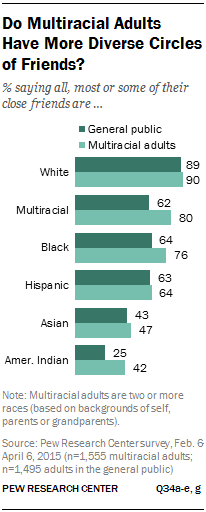
A majority of Americans say they have at least some close friends who are white, black, Hispanic or mixed race. And somewhat smaller shares say they have close friends who are Asian and American Indian. Multiracial adults are more likely than the general public to say that at least some of their close friends are mixed race, black or American Indian. In fact, one-in-six (16%) multiracial adults say all or most of their close friends are multiracial, compared with only 6% of the general public.
While friendship clearly transcends race and ethnicity, the two are strongly correlated. Individuals tend to have more friends among their own race group than they do among races that are different than their own.
Among adults who are white with no other race in their background, fully 81% say that all or most of their close friends are white. Among single-race blacks, 70% say that all or most of their close friends are black. And among single-race Asians, 54% say all or most of their close friends are Asian.
For multiracial adults, their close friends reflect their own mixed racial composition to some extent, but the patterns are complicated and difficult to unpack.
Looking first at the share of adults who say their close friends are white, those who have a mixed white and black racial background are somewhat more likely than those who are single-race black to say all or most of their friends are white. But the share saying this is relatively low for both groups: 18% of biracial white and black adults and 10% of single-race blacks say all or most of their friends are white. Among single-race blacks, 27% say none of their close friends are white.
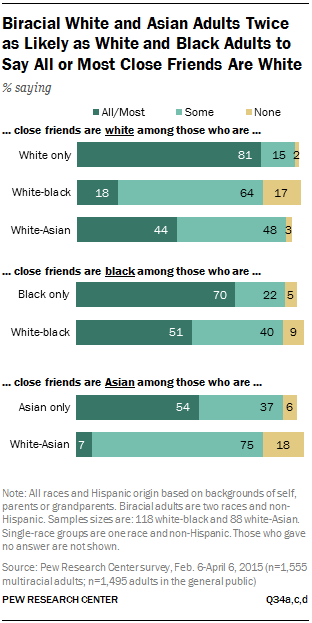
Adults who are a mix of white and Asian are much more likely than biracial white and black adults to report that all or most of their close friends are white (44% do). By comparison, about half as many adults who are single-race Asian (21%) report that all or most of their close friends are white.
Biracial adults with a mixed white and black background report having more close friends who are black than white. About half of white and black biracial adults (51%) say all or most of their close friends are black. By comparison, 70% of single-race blacks say all or most of their friends are black. Only 2% of single-race whites say all or most of their close friends are black, while 36% say none of their close friends are black.
By contrast, biracial adults with a mixed Asian and white background report having more close friends who are white than Asian. Among biracial Asian and white adults, 7% say all or most of their close friends are Asian. Among single-race Asians, fully 54% say all or most of their close friends are Asian. Relatively few single-race whites (2%) say all or most of their friends are Asian; fully 55% say they have no Asian friends.
Just as multiracial adults with American Indian backgrounds say they have little in common with American Indians, relatively few of these mixed-race adults report having a lot of close friends who are Native American. For biracial adults who are white and American Indian, a solid majority (72%) say all or most of their close friends are white. And for those who are black and American Indian, a similar share (68%) say all or most of their close friends are black.
Among biracial white and American Indian adults, 48% say they have at least some close friends who are Native American, and 51% say they have none. The share of black and American Indian biracial adults who say they have no close friends who are Native American is even higher (69%).
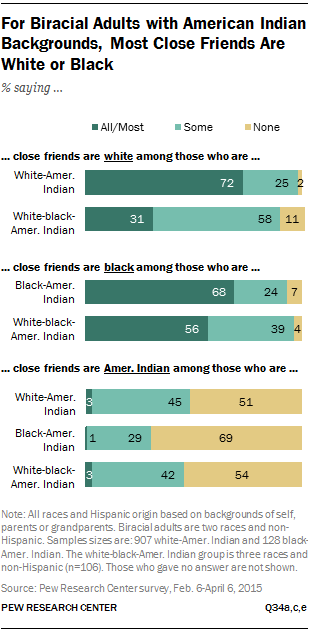
For multiracial adults who are white, black and American Indian, their inner circle of friends tends to reflect their mixed white and black heritage rather than their Native American roots. Some 56% of these adults say all of most of their close friends are black, and about three-in-ten (31%) say all or most of their close friends are white. By contrast, only 3% say all or most of their close friends are American Indian.
As a group, multiracial Hispanics have a diversity of close friends. About four-in-ten (38%) say all or most of their close friends are white, and 29% say all or most of their close friends are Hispanic.
Like other mixed-race groups, multiracial Hispanics are more likely than the general public to say many of their friends are multiracial. In fact the share of multiracial Hispanics saying all or most of their friends are mixed race (25%) is roughly the same as the share saying all or most of their friends are Hispanic. Overall, only 6% of American adults say all or most of their close friends are multiracial.
The Racial Composition of Neighborhoods

A majority of American adults (58%) say all or most of the people who live in their neighborhood are white. The experience of mixed-race adults is not entirely different. A similar share of multiracial adults (54%) say all or most of the people in their neighborhood are white. And just as is the case with the general public, relatively few say they live in neighborhoods that are mostly non-white.
Even so, multiracial adults are more likely than all American adults to say all or most of the people in their neighborhood are black (14% among multiracial vs. 10% among the general public). And they are also more likely to say that all or most of their neighbors are mixed race (10% vs. 5% among the general public).
The racial composition of neighborhoods differs significantly across racial and ethnic groups. And the differences are sharpest among groups of single-race adults. Fully 73% of adults who are white and no other race say all or most of the people in their neighborhood are white. By comparison, 49% of adults who are Asian and no other race say all or most of the people in their neighborhood are white. Among single-race black adults, only 27% say all or most of the people in their neighborhood are white.
Biracial white and black adults are more likely than single-race blacks to say all or most of their neighbors are white—42% say so. But they are just as likely as single-race blacks to say all or most of their neighbors are black. Some 37% of single-race blacks say this, as do 32% of white and black adults.

Biracial white and Asian adults are somewhat more likely than single-race Asians to report a higher concentration of white people in their neighborhood: 63% of white and Asian adults say all or most of the people in their neighborhood are white, and 49% of single-race Asian adults say the same. The opposite is true when it comes to the concentration of Asian people in their neighborhood. Among adults who are single-race Asian, 17% say all or most of the people in their neighborhood are Asian, while only 9% of biracial white and Asian adults say the same. Among white and Asian adults, about one-in-four (24%) say there are no Asians in their neighborhood.
Among multiracial adults with American Indian backgrounds, very few live in communities that are predominantly American Indian. About two-thirds of biracial white and American Indian adults (66%) say that all or most of the people in their neighborhood are white, while only 1% say all or most of the people in their neighborhood are American Indian. Fully 64% of this group says none of their neighbors share their Native American heritage.

For biracial adults who are black and American Indian, the racial composition of their neighborhoods looks a lot like that of single-race blacks. About one-in-four (26%) say all or most of the people in their neighborhood are white, and 45% say all or most of them are black. None of these biracial black and American Indian adults say that their neighborhood is predominantly Native American.
Among adults who are white, black and American Indian, a significant share (19%) say that all or most of the people in their neighborhood are multiracial. They are more likely than biracial white and American Indian adults (8%) or biracial black and American Indian adults (4%) to say their neighborhood is mainly mixed race.
Multiracial adults who are Hispanic and two other races don’t tend to live in predominantly Hispanic neighborhoods. About half (52%) say that all or most of the people in their neighborhood are white. This compares with 58% among the general public.
Roughly one-in-five multiracial Hispanics (21%) say all or most of the people in their neighborhood are Hispanic. This is not significantly higher than the share of the general public saying all or most of the people in their neighborhood are Hispanic (15%). Some 15% of multiracial Hispanics say all or most of the people in their neighborhood are multiracial.
Race and Family Dynamics
By definition, multiracial adults have family members with different racial backgrounds. For some mixed-race adults, this is difficult terrain to navigate; for others, it’s relatively easy. To be sure, family dynamics are influenced by many factors other than race. Still, the survey finds that, overall, biracial adults tend to have more contact with relatives from one of the races that make up their background than they do with the other.

For example, biracial adults who are white and black have had much more contact with their black family members than with their white family members. Fully 69% say, over the course of their life, they have had a lot of contact with their relatives who are black, an additional 19% say they’ve had some contact with their black relatives and 12% say they’ve had only a little or no contact with them.
By contrast, 21% of biracial white and black adults say they have had a lot of contact with their relatives who are white, and 13% say they have had some contact. One-in-four say they’ve only had a little bit of contact with their white relatives, and 41% say they have had no contact with them at all.
For biracial white and Asian adults, patterns of family contact are quite different. Roughly six-in-ten (61%) white and Asian adults say they have had a lot of contact with their white relatives, while fewer (42%) say they have had a lot of contact with their Asian relatives. About a third (35%) say they’ve had some contact with their Asian family members, and an additional one-in-five say they have had only a little (16%) or no contact (7%) with their Asian relatives. It’s worth noting that many adults with Asian backgrounds were born outside of the U.S. and so may be more likely to have relatives who live in other countries.
For biracial adults with an American Indian background, family connections are much stronger with their white or black relatives than with their family members who are American Indian. Among those adults who are white and American Indian, 81% say they have had a lot of contact with their white relatives, while only 19% say they have had a lot of contact with their American Indian relatives. Similarly, among adults who are black and American Indian, 77% have had a lot of contact with their black family members, and 7% have had a lot of contact with their relatives who are American Indian.
Multiracial adults who are white, black and American Indian tend to be in closest contact with their black family members. Some 78% say they have had a lot of contact with their black relatives, 31% say the same about their white relatives and 15% say they’ve been in close touch with their family members who are Native American.
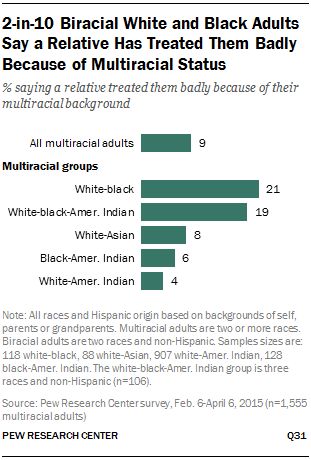
While some multiracial adults report limited contact with certain racial groups in their family, relatively few say that they’ve been treated badly by family members because of their mixed-race background. Overall, 9% of multiracial adults say that a relative or member of their extended family has treated them badly because they are mixed race. Nine-in-ten say this has not happened to them.
Some multiracial groups are more likely than others to say they have had this type of experience. Among biracial adults who are white and black, 21% say they have been treated badly by a relative because of their mixed-race background. And 19% of multiracial adults who are white, black and American Indian say the same.
Biracial adults who are white and American Indian (4%) or black and American Indian (6%) are somewhat less likely to report having had this type of experience with a family member. Among biracial adults who are white and Asian, 8% say they have been treated badly by a family member because of their multiracial background.
Race, Marriage and Intermarriage
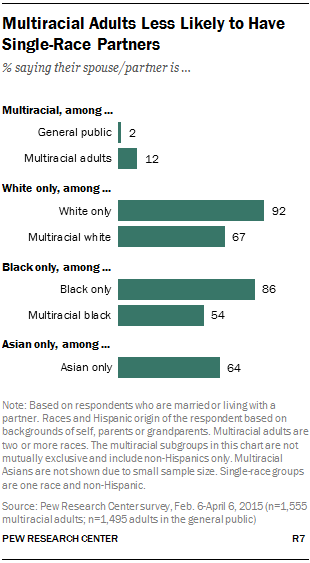
In 2013, about one-in-eight (12%) new marriages in the U.S. were between spouses of different races, according to a Pew Research analysis of American Community Survey data. The share of adults marrying outside of their own group has risen steadily in recent decades, and this trend in turn has helped fuel the growth in the nation’s multiracial population.
Multiracial adults, many of whom are themselves the product of interracial marriages, are much more likely than all married adults to have a spouse or partner who is also multiracial. Among all mixed-race adults who are married or living with a partner, about one-in-eight (12%) say their spouse or partner is two or more races. By comparison, only 2% of married adults among the general public say the same.
The vast majority of single-race whites and blacks who are married or living with someone report that their spouse or partner shares their single-race background. Among adults who are white only, 92% have a spouse or partner who is also white only. Multiracial adults with a white background are much less likely to be married to someone who is white only. Two-thirds of multiracial whites say they have a white spouse or partner. Similarly, multiracial adults with a black background are less likely than single-race blacks to have a spouse or partner who is black only (54% vs. 86%).47
Single-race Asians are more likely than single-race whites or blacks to marry outside of their racial group: 64% say their spouse or partner is Asian only. An additional 31% of this group has a white spouse or partner.
Among multiracial Hispanics who are married or living with a partner, about half (48%) identify their spouse as being single-race white. One-in-five (19%) have a spouse or partner who is Hispanic only, and 13% have a spouse or partner who is black only. Some 10% of multiracial Hispanics have a multiracial spouse or partner.
My grandfather married a white woman in South Carolina and so they were married in the ’50s, South Carolina. Deep segregation. … Most people thought he was black, and so for a black man to be marrying a white woman at the time—it was completely uncouth. So they dealt with a lot of—a lot of—that sort of racism in the South.White and American Indian biracial man, age 23